Reworking KS4 Assessment in preparation for the specification changes
Planning for a curriculum change can often induce panic. We are all very aware of what is coming our way in terms of the planning and resourcing we will need to do; but we need to react tactically to not induce a work-overload or to panic colleagues. In this blog, I will look at how to avoid reaching the end of the line with our resources, with a focus on assessment in particular, to avoid overload of creating new resources. I aim to look at how we can use and alter certain aspects of assessment for the current specification and change them into tasks appropriate for the new specification by looking at my plans for assessment for the Learning Area I lead.
Planning for assessment change
I teach AQA and fully intend on sticking with AQA for the new specification, but the process I would follow if I were using Edexcel or Eduqas would be the same and it all hinges on the SAMS materials.
Firstly, look at the question paper and identify what similarities exist between the specification you currently teach and the new specification. These will help you identify areas that will be quick to adapt with very little effort. Where there are differences, this is where more considered thought will need to go in order to potentially overhaul the assessment and where I would turn to other sources of assessment materials, such as ZigZag, Viva or Kerboodle assessments to support me in this, especially to avoid spending hours flicking through vocabulary lists; although I think this has its problems in that, especially for those we are eyeing up for A Level, we need to expose students to as much vocab as possible and dealing with unfamiliar vocabulary. It’s also important to look at the rubrics as some of the tasks may look visually similar but there may be subtle differences in the rubrics to think about, such as language changes or clearer instructions to give.

Having done this, turn to the mark schemes and look at the demands of each task. Understanding of the mark scheme, in my eyes, is key to avoid prematurely fatiguing students in an exam situation when it is not necessary. A classic example was teaching PALMA in the current AQA specification for describing a photograph in the speaking exam (looking at people, action, location, mood, add a detail) when they would get the same amount of credit by stating three sentences starting with ‘There is/there are”.
Looking at the mark schemes is also really important when looking at data trackers for mark distribution, something I will look at if we have enough time or return to at a later stage.
Being aware of key differences
Having an awareness of key changes from your old specification is vital to aid you make effective tweaks to what you already have – whether you are sticking with the same exam board or switching.
Similarities and differences: My conclusions
Writing paper for both exams: very similar to what we already have, albeit with all rubrics in English. There are differences in the number of words required for some tasks and the number of bullet points. Mark schemes are very similarly worded, especially AQA. There are some slight differences in length of writing exams and the inclusion of a specific grammar question for AQA foundation.
Section A of reading and listening papers appear very similar to what we already have, albeit with the exclusion of certain exam tasks by some exam boards (AQA removal of true, false, not mentioned questions) and three repeats of each question by Edexcel. The differences come in the dictation.
Speaking paper initially looks different; scratch the surface and a lot of it is very similar, especially for AQA when you look at the wording of the mark schemes.
Adaptation will be easier for speaking and writing; more challenging for reading and listening owing to the vocabulary checking and the three plays and slowing down of the listening transcript.
Reworking our Key Stage 4 Assessment Schedule
My school is very much data-driven. We had an old system that myself and my predecessor drew up that we think worked well. It covered the full skill set as best we could in lesson time for Year 9 and 10 (Year 9 now falls under the Key Stage 3 assessment model) and allowed for cumulation of marks. It gave us a very good idea for tiering and also allowed for 30 marks to be gained straight away in the first speaking mock in Y11, so the vast majority of students would see their grade go up in Y11 and boost their confidence. This is something I am keep to replicate for the new specification.
When redesigning the assessment for next year, I wanted the same coverage of skills and I also wanted to allow for marks to be up for grabs in Y11 for the confidence boost. To do this, I have coupled up the photocard description (5 marks in total, should take maximum of 1 minute) with the read aloud (again, more or less 1 minute) and the four follow up read aloud questions (2-3 minutes). This equates to just slightly more time than the current photocard (2 minutes, give or take) and allows students access to a range of marks for speaking – leaving students only having not had access to 20 marks up for grabs for the photocard follow-up questions.
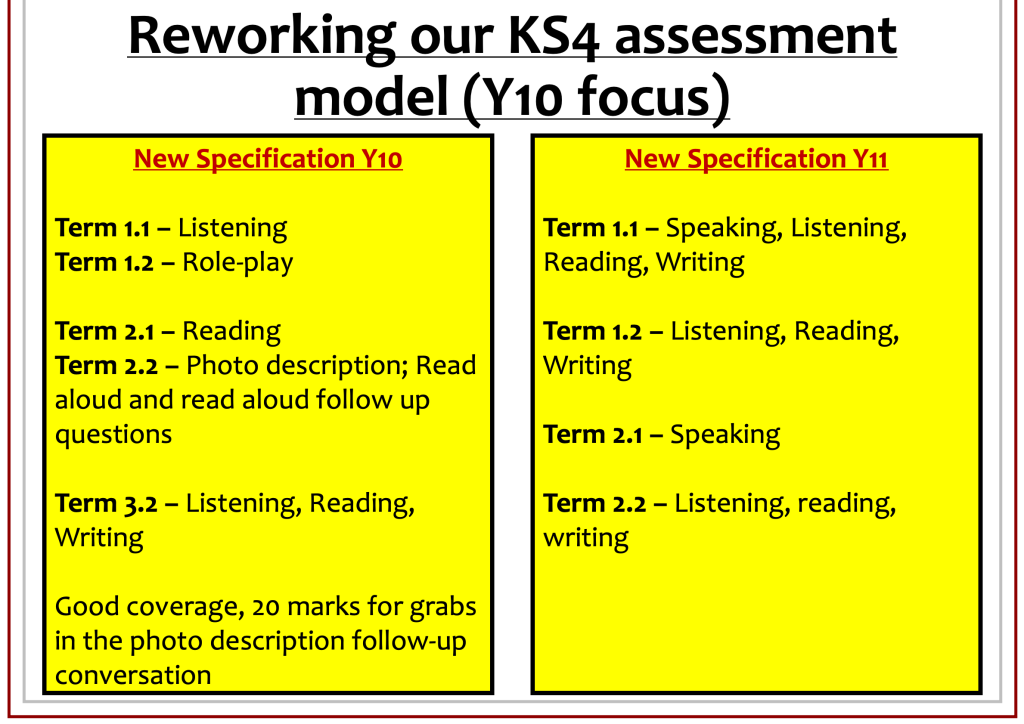
One consideration, as always, is that the exam boards are expected to only produce 2 rounds of SAMS material. When next year’s Y10s go through this cycle, along with their October written mocks, December written mocks and April written mocks, I will need: 5 sets of reading and listening exams; 4 sets of writing exams; and 3 sets of speaking – meaning I will have to rework what we have.
As we are starting this assessment with Year 9 this year and Year 10 next year, our Y9 only are tested on Foundation to give a good base of data ready for the transition to higher tier, so I will focus on the foundation tier.
Reworking our assessments: Speaking
The role-play I found more or less straight forward to reversion for new assessments for my school. The key thing is to understand is whether your specification uses transactional role-plays, where students have to buy something or catch a train somewhere (Edexcel), or if your exam board has non-transactional role-plays (AQA). To reversion for the new AQA specification, I took role-play 3 from the foundation tier SAMS 2018 as a basis. I reversioned by looking at the teacher prompts, putting them into English and starting each one with the commands: ”Say” or “Ask” as per the SAMS for the new specification.
I reformatted the instructions so that these are all in English, as well as the tasks, but the actual teacher script will stay in Spanish, as per printed in the SAMS – so no need to change. As well as this, in the legacy spec there was confusion as to whether students needed to use a verb or not – this time the blanket approach is that they do need to use one, so I inserted this into the rubric.

In order to give feedback, and ensure no staff give `KUL marks (these are now gone for role-plays!) I created a little feedback sheet that should spell out the criteria clearly for students and for staff and enable them to give accurate feedback and set personalised targets.
Reworking the role-play for Edexcel is slightly different in that some of the role-plays are transactional – meaning that they take place in a specific setting – such as in town, in a hotel, in a hospital etc. and students must ask for items and say what they want/need. To adapt for Edexcel, ensure to give the role-play a specific setting, give some scenario and ensure the bullets tie in and flow with the scenario. Note that there is no ? to indicate a question
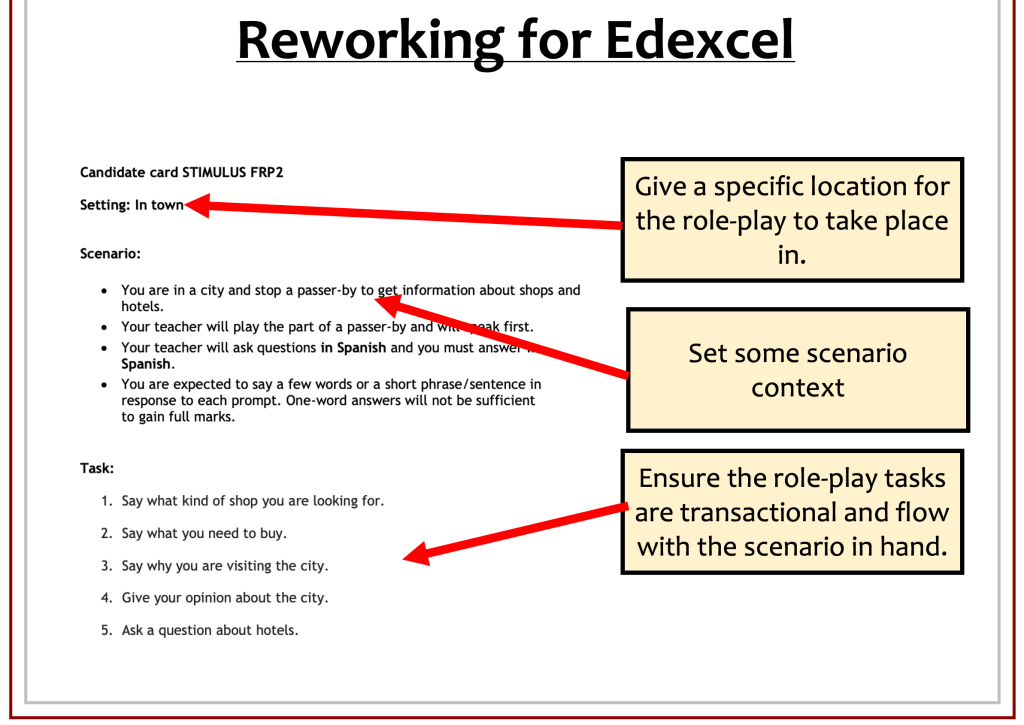
Combining the photo card and read aloud tasks
As you will have seen in the earlier slide, at the moment we have two sets of speaking we assess in Y9 and Y10 – role-play and photo card. The new photo card task demands a follow-up conversation-style task that lasts a lot longer than the current time allotted to the photo card. I’ve decided to blend the photograph decription (1 minute), the read aloud (maximum 2 minutes) and follow up questions (2-or-so minutes) together for Y9 and Y10. The reason being students will still get access to a large amount of marks and it takes less time than holding a photo card and general conversation follow-up.
For the photocard and read aloud combination, I started with the photocard. The first thing that is important to change is the wording of the rubric as there’s now no printed follow-on questions for AQA and it also specifies students must reference both photos for full marks. It is quite easy to reuse the photographs from the outgoing specification as a basis, but you will need to look for related second photographs and perhaps it’s an opportune moment to check for diversity and representation. For this, the SAMS papers are good for inspiration. I googled similar photos and changed from colour to black and white in order to replicate the exam.

Reworking the photocard for Edexcel is just as simple but there are a few intracacies to watch out for. Images are arranged left-to-right rather than above and below each other. This time, students need only describe one photo – so this needs to be made clear in the exam rubric. In Edexcel, in order to score full marks, students must describe the people, the location and the activity, which is different to AQA. In this instance, PALMA may work well for this specification.If I were doing this task, I would also follow up with the two short follow up questions as these should not take students long to answer and will give them access to more marks to put in for data collection purposes.

The read aloud and follow-up questions are slightly more tricky. For this I had to take inspiration from SAMS. On word counting, the SAMS read aloud tasks are 50 words, split into 5 sentences at foundation; 6 at higher. Therefore I replicated this in my creation. I used the AQA SAMS as a basis, altering slightly, ensuring that the words were on the word list, cross checking with Excel. I also ensured that the rubric was in English, with a note to the follow up questions that would be coming and what topic they would be on. One of the big things I thought was good about the AQA read aloud was the size and clarity of the text and layout, therefore, I increased the text size and spacing on the version I created to replicate, too.
The follow up questions are based on the SAMS but altered to cover things such as describing their ideal teacher, for instance. We will follow this with four questions, all of which will be in the present tense for students to answer.
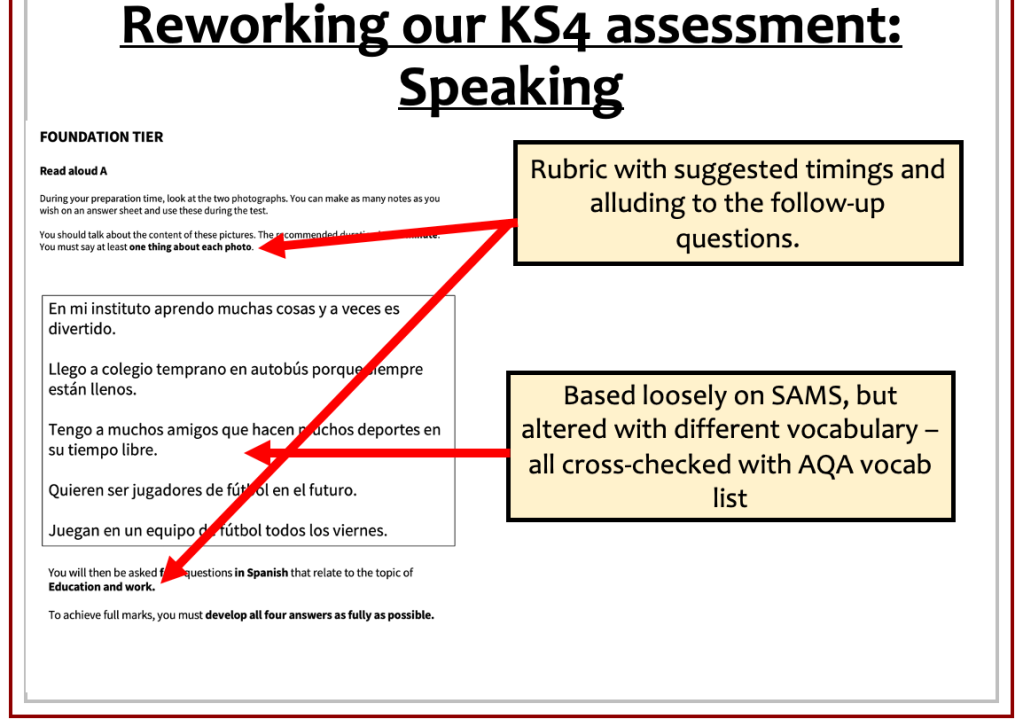
For Edexcel there are only 4 sentences but they are longer – a few of them span over two lines. The text is the same size, as well, and not boxed off. These are all considerations that we need to prepare students for in the real thing as this is what they may look like. Another consideration is that there are only two follow up questions this time and the development need not be as long.

To accompany the new photocard and the read aloud, a student and staff friendly feedback sheet was needed. I suspect given the focus on ‘information conveyed’ and looking at communication, a similar marking system that is found in the current specification for the photocard may be deployed. See the image on the left-hand side. As is such, I have created a similar system for this task, but noticeably without the need for the opinion or the justification. I have also set the bar slightly higher than the current photo card communication marks as AQA talk about minimally developed, which we don’t know if that means an additional detail or one additional verb) and fully developed (which we don’t know if that means one additional verb or two additional verbs) – so I’ve veered on the edge of caution and set the bar higher.
I also opted to copy and paste the read aloud text, so staff can highlight where serious errors occur to help inform their decision, as well as opting to highlight that it is the corrected version of a sound that is accepted. This is as much CPD for staff as it is feedback for our students so I need to make these intricacies as explicit as possible. Below you can see the feedback sheet on the left, and the current photo card symbols used by AQA.

Reworking our assessments: Writing
The first thing to note, for AQA in particular, is that the paper is divided up into sections, and I presume the reasoning for this is to indicate which parts of the writing exam are compulsory (photograph, 50-word task, grammar and translation) and which bits have an optional element (90-word task). This had to be clear on the instructions page to verse students ahead of their final exams in Y11 of the optionality of the 90-word task and the compulsory nature of the rest of the paper.
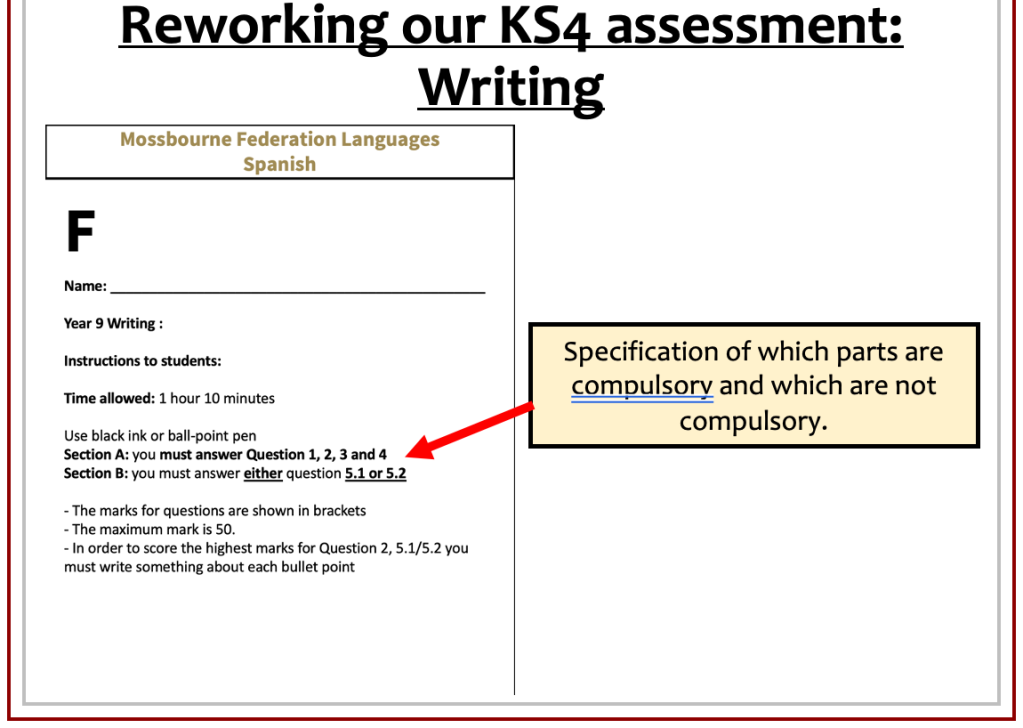
What I liked more than anything about the new specifications is that both exam board papers flows in a very similar order to current writing paper – making it a known for us and for students. There are, however, some differences. On the AQA exam, as teachers, it is important to note that the overall mark has descended from 60 to 50 marks and the distribution of marks across tasks is different compared to the current specification.The Higher tier paper is more similar, albeit a change in the order of questions (Higher translation first) and translation divided up into sentences. As we are starting this assessment with Year 9 this year and Year 10 next year, our Y9 only are tested on Foundation to give a good base of data ready for the transition to higher tier, so I will focus on the foundation tier.
The photo card
Starting with the photocard, there is a lot of scope to use what is already available. When adapting to meet the needs of the new specification for AQA, there are a few things to consider. Firstly, as mentioned before, it is important to note that this is now labelled as the start of Section A. All rubrics need to be put into English, which is a pretty straight forward task. The last consideration is that there are now 5 sentences to write, rather than 4.

In terms of recyclability, the photographs from the old specification are ideal to use. When using our own photos, I greyscaled these to match what students would receive in the exam itself.
For Edexcel it is still just 4 sentences. What is important to note is that the pictures in the SAMS material are published in colour, opening up opportunity for students to describe nouns using adjectives. It remains to be seen if this will happen in the real exam and it’s something to keep an eye out for when the first sitting happens to keep the simulation of the exam as real as possible.
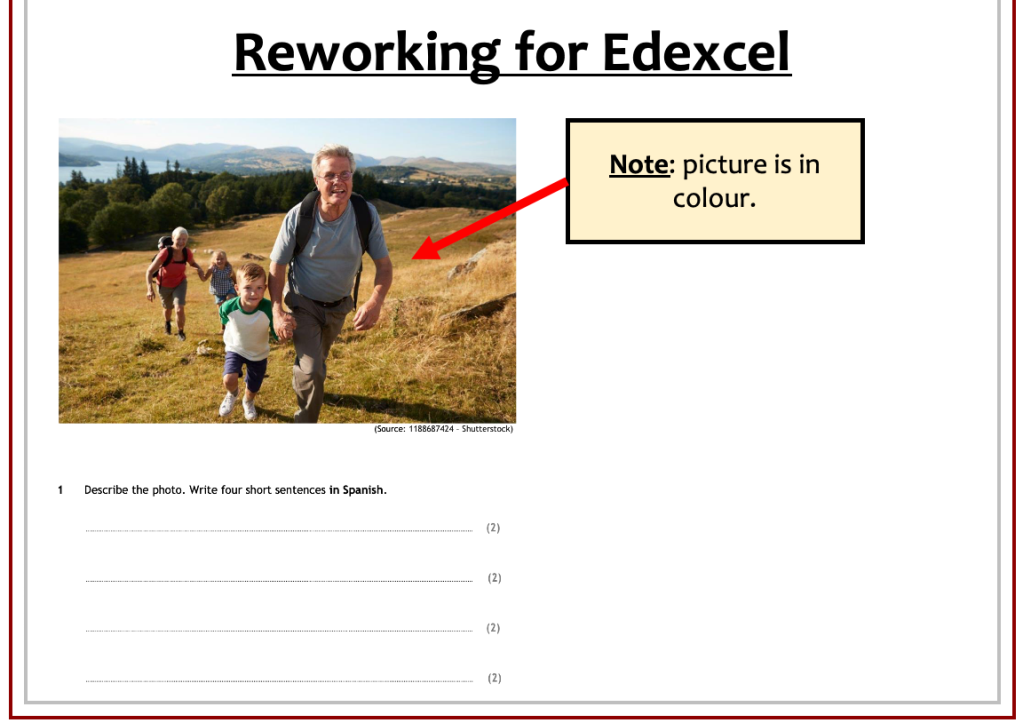
The shorter writing task
Next is the short writing task. Starting with AQA, this is not optional just like the current specification and the overall aims when looking at the mark schemes are similar – it’s not about sophistication, but communicating clearly in the target language.
First change from the legacy specification is that the rubrics are again, written in English and the length of the piece is increased by 10 words to 50 words. This was important to highlight to students when I created our new version for the summer. To facilitate for this to happen, AQA have added another bullet point for students to respond to. Bullet points are similar in length to the current specification – mostly one-word points.

A big change was to signpost to students that this task, rather than being worth 16 marks as it is in the current specification, is now worth 10 marks – another thing that is important to signpost to students.
Reversioning for Edexcel of the short writing task is straightforward, too. There are still two options for the short writing task, as there is in the current specification, so if I were producing assessment material for the Edexcel course, I would look to replicate this for my students. All of the tasks still take the form of short sentences but when adapting, it’s important to reduce the number of bullet points from 4 down to 3. Another thing to note is that one of these points, as in the previous spec, will be in another time frame. The one in SAMS is in the future.

New to AQA Foundation only – the grammar question
Question 3 is a new task entirely and only found on AQA foundation. It is the only task that requires a complete rethink on the writing paper. It does not exist in the Edexcel SAMS. It is 5 multiple choice questions that are designed to test a student’s knowledge of grammar. Students must write out the word in the gap and it is one of the few tasks where an example is given. As is such, when recreating the assessments for my learning area, I have included an example to mirror this.
When looking at the SAMS, the things that this task is testing are:
– Verb endings for different people
– Adjectival agreement
– Apocopation of common expressions, such as buen tiempo, mal comportamiento
– Formation of future tense (using the infinitive)
So when recreating for our students, I kept as close to the requirements in the SAMS, checking the vocabulary I was including featured on the AQA word list. Vocab from outside the word list shouldn’t feature in this question.
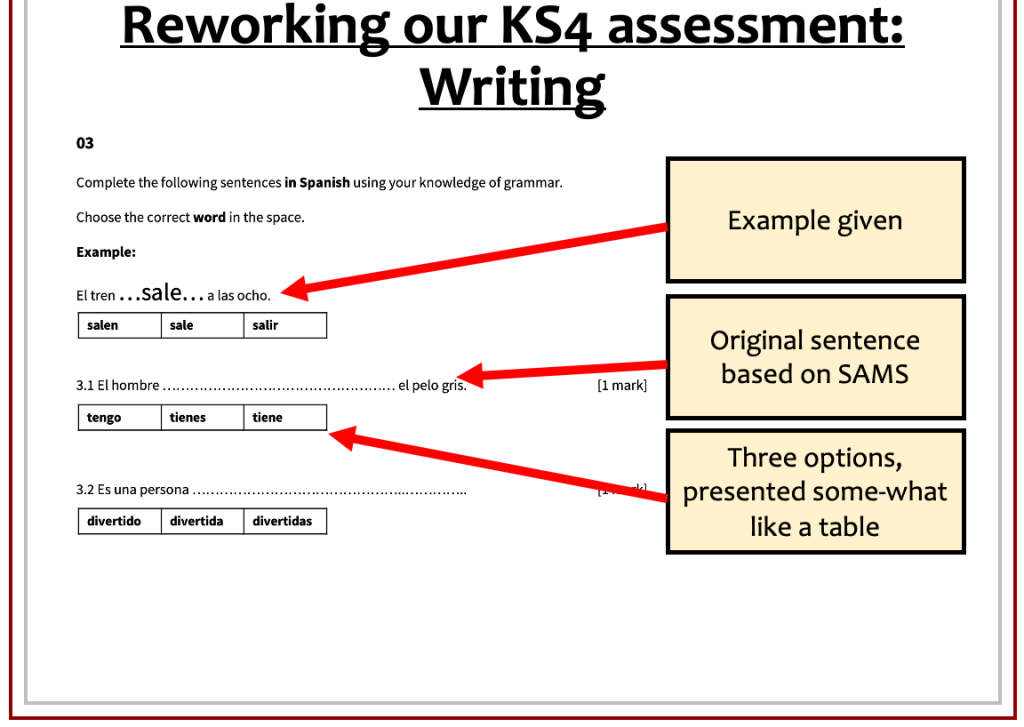
Translation
The translation is also very similar to the current set up; but the one thing to be aware of in the translation is to not test for vocabulary that is off-specification. So when I constructed our example for the AQA specification, I referenced the AQA vocabulary list throughout to ensure that these confines were met. The format is exactly the same as the current translation in that it is in short sentences, one sentence will test the past time frame and another the future. The marking is also done in a very similar way, adding up ticks for a communication mark; but the wording of the second set of criteria, Knowledge of Vocabulary and Grammar, is different to that of the current specification.
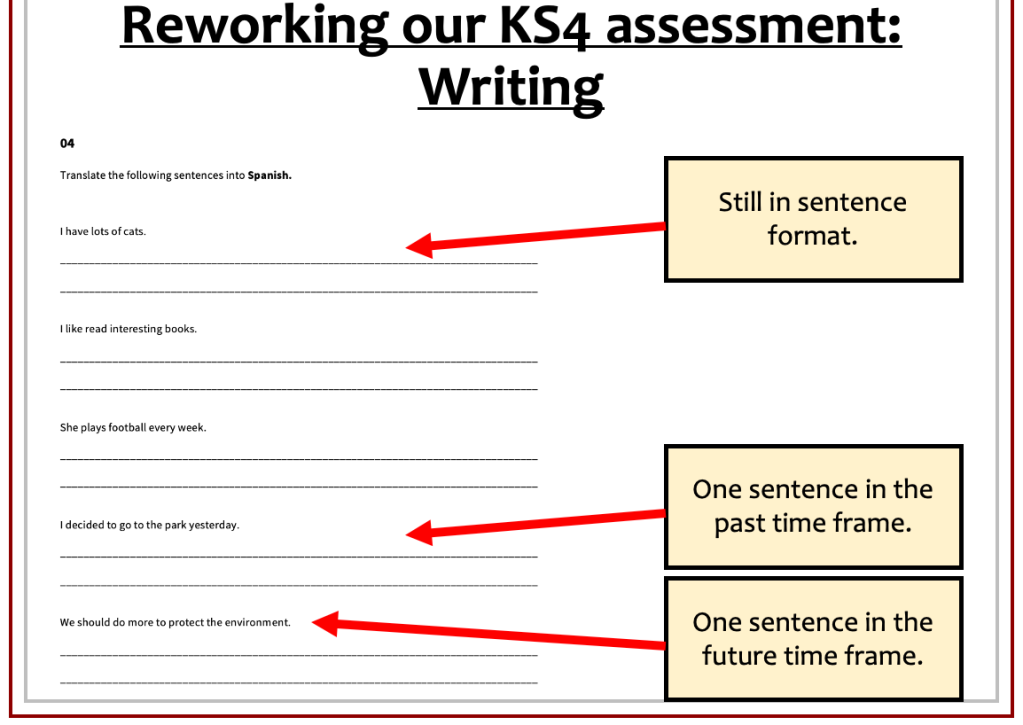
For Edexcel, it is still sentence format; however, there is only one line in the SAMS for writing answers rather than 2 lines. Again, most sentences are in the present tense with one in a different time frame. In the SAMS, this is the past time frame, as per the current specification.

Foundation/Higher Overlap Question
The overlap question on both specifications also feels familiar. For AQA, it is still optional in that there are two choices and this I have replicated on the assessments I have created. As mentioned earlier, the foundation paper is divided up into Section A and Section B, with Section B containing the two 90-word question options. I have labelled this in the assessments I have created. Instructions are now all in English. The original tasks from the current specification are also ideal to use as a basis, but again, be careful to check that the topics appear on the new specification. This time, there are only 3 bullet points. As per the current spec, one is in the future time frame, one in the past time frame and one elicits an opinion – so replicating this in my assessment was important so students could meet the demands of the mark schemes. Another thing that I mirrored when creating my assessments was to highlight the change of maximum mark – which for the new specification stands at 15 marks. Overall, there is a lot that can be recycled from the current specification and adapted by translating for the new specification – so long as the prerequisite time frames and opinion bullet point are met.
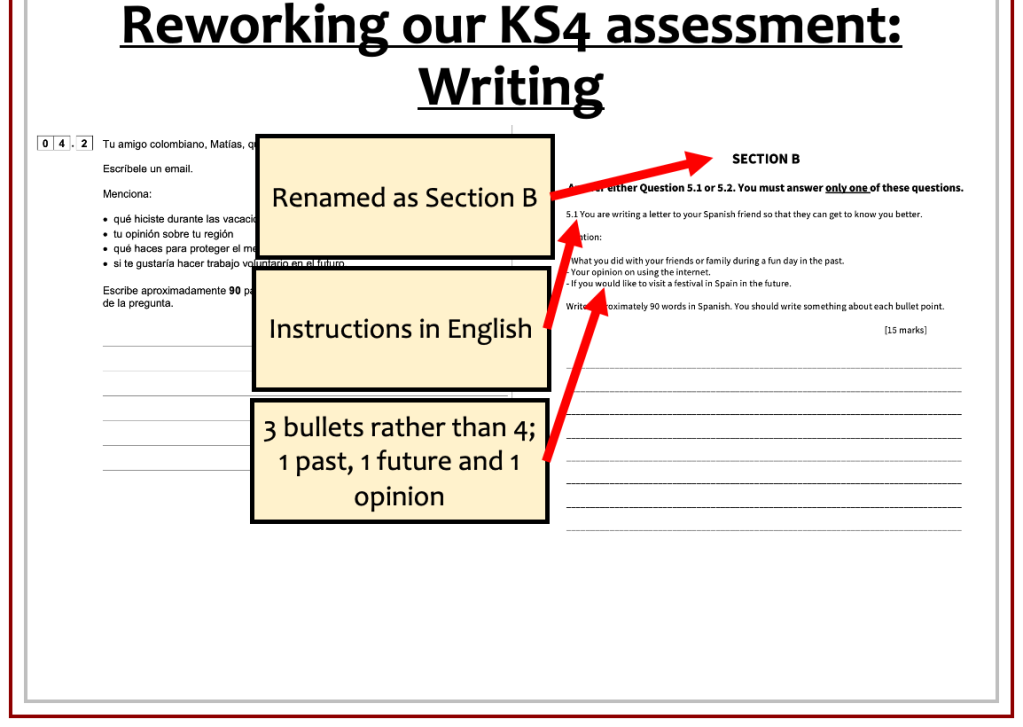
Edexcel have kept the 80-90 word task very similar to what already exists. albeit the formatting of double spacing between the task bullet points appears to have gone. The optionality of two choices still exists and all tasks are written in English. One point elicits the past time frame, and one the future time frame. Again, a lot can be recycled from the current specification – so long as it lends itself to the thematic content that Edexcel have laid out in the specification.

Reworking our assessments: Reading
When looking at the reading and compiling our assessments for Year 9 and 10, I will draw from the current specification questions, and possibly the older specification, to start with for section A of the reading exam. Two considerations I will need to make when adapting for AQA are:
– Not to include T/F/NM-style questions which have been removed
– Cross check for vocabulary that is off-list and gloss as necessary.
When looking at the translation section, I will draw from what exists but again, adapt:
– Firstly, by ensuring all vocabulary is on the specification.
– The balance of time frames and sentence lengths are similar to that of the SAMS.
– The translation is in sentences and not in a paragraph.
To help me do this, I will look to Edexcel exams, ExamPro, ZigZag, Kerboodle and the new Pearson textbook to lift extra exam-style activities, adapting as I see fit to ensure that they work for the new specification.
Reworking our assessments: Listening
For the listening and compiling our assessments for Year 9 and 10, I will draw from the current specification questions, and possibly the older specification, to start with for section A of the listening exam. Again, a consideration for this section is ensuring that there is no off-specification vocabulary included. For Edexcel, this may require a bit more work as the listening tracks will be repeated 3 times, which may involve duplicating tracks or searching more from other sources such as Active Teach, Kerboodle, Pearson and ZigZag to help reduce workload here.
The dictation will be slightly more tricky, with AQA offering three repeats – an initial and final full-sentence read, with a sectioned second listen sandwiched in between. To help with this, again I will look to Edexcel exams, ExamPro, ZigZag, Kerboodle and Pearson to lift extra exam-style activities, adapting as I see fit to ensure that they work for the new specification. If I am not happy with the quality of what is produced, I will author my own and ask our assistants to record for us to guarantee quality. This is a great way to get language assistants involved.
Classroom-level implications
On a classroom level, there are many resources that can be easily manipulated. As seen with the writing exam, a lot of it is very similar and the biggest change is translating it into English and checking that the points will allow students to practice the themes/topics covered by their specification – be it Edexcel or AQA. This is the bit that will take the biggest amount of thinking by teachers in my eyes and one consideration that could be easy to overlook. Apart from that, other implications and tweaks include altering the number of sentences for the photograph task to 5 for AQA. Finally, it’s a case of checking the number of bullet points to ensure these match the tasks and contain the assessment constructs that the exam looks to alter and that we want students to practice in lessons.
With the speaking exam, there is a little bit more to think about. Starting with the roleplay, the big thing is changing the points into English and using ‘say’ and ‘ask’ statements, particularly for AQA. Care will need to be taken to remove any ‘transactional’ elements, such as buying tickets or clothes, if teaching AQA; or conversely changing role-plays to include these elements if teaching Edexcel. All surprise questions will need to be included in tasks as written ‘known’ tasks as there will be no surprise elements. For the read aloud, practicing reading aloud of reading texts in class to build up self esteem and to allow students to practice. Lots of mini whiteboard work will also be key as this can lead to higher student confidence. Finally for the photo card question, there is the need to include 2 photographs – be it compulsory to talk about both for AQA and training our students to talk about both, or choosing the one students can say most about if using the Edexcel specification. As well, for Edexcel, training students to talk about people, location, actions and emotions to describe the photograph.
Finally, we must prepare our students to engage with conversation – preparing questions and ensuring they develop their answers with structures, hitting all time frames.

